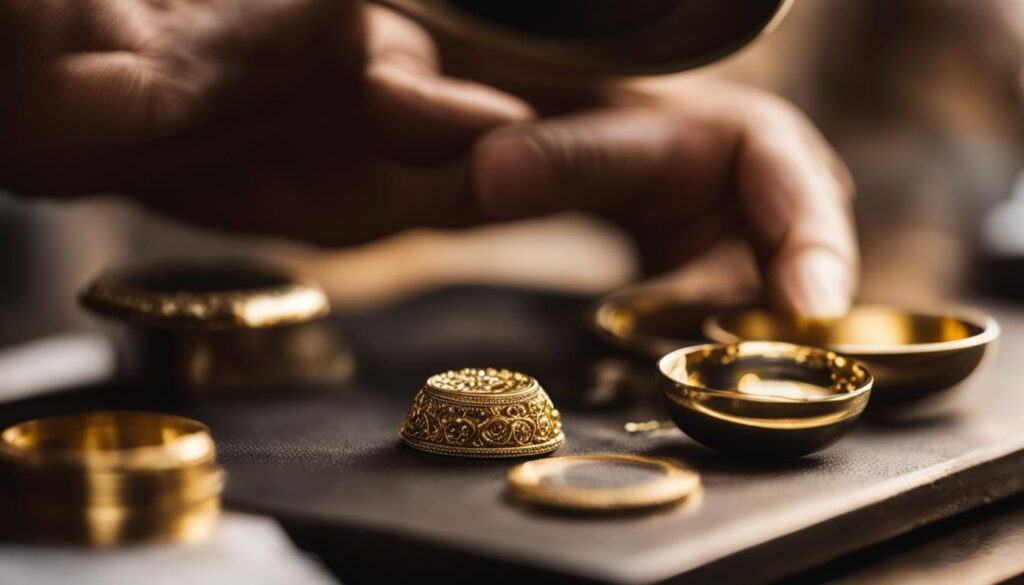In India, the question of whether gold jewelry is hallmarked is a common concern among consumers. Unlike British hallmarking, there is no mandatory requirement for gold jewelry to be hallmarked or assayed in India. This lack of regulation means that consumers have no guarantee regarding the purity of gold in the jewelry they purchase.
However, in an effort to ensure more certainty in the Indian gold industry, the Bureau of Indian Standards (BIS) introduced a voluntary hallmarking scheme in 2000. This scheme allows jewelers to obtain a BIS hallmark for their gold jewelry, indicating that it meets the required standards of purity and fineness.
The BIS hallmark consists of a series of elements including the BIS logo, the purity of the item, the assaying and hallmarking center’s mark, the date letter, and the jeweler’s identification mark. These elements help consumers identify genuine hallmarked gold and provide assurance of its quality.
In this article, I will discuss the BIS hallmarking scheme, how to identify hallmarked gold in India, and the upcoming changes in hallmarking rules that aim to enhance transparency and consumer confidence.
Key Takeaways:
- Indian gold jewelry is not mandatory required to be hallmarked or assayed.
- The Bureau of Indian Standards (BIS) introduced a voluntary hallmarking scheme in 2000.
- The BIS hallmark includes the BIS logo, purity, assaying and hallmarking center’s mark, date letter, and jeweler’s identification mark.
- Identifying hallmarked gold in India helps ensure its quality and purity.
- New hallmarking rules will be implemented in 2023 to further enhance transparency and authenticity.
The BIS Logo
The BIS logo is the official hallmark for gold jewelry in India. Jewelers who wish to use the BIS mark must obtain a license and adhere to strict guidelines regarding the purity of marked items. The BIS logo provides assurance to consumers that the gold jewelry they are purchasing meets the required standards of purity and fineness.

Illustration: The BIS logo represents the hallmark for gold jewelry in India.
Purity / Fineness
In the BIS hallmarking scheme, different gold purities are recognized. These purity levels determine the percentage of gold content in the jewelry item, providing consumers with valuable information about its quality and value.
Here are the various gold purities and their corresponding carat numbers:
| Purity | Carat Number |
|---|---|
| 9 carat | 375 |
| 14 carat | 585 |
| 18 carat | 750 |
| 21 carat | 875 |
| 22 carat | 916 |
| 23 carat | 958 |
It’s important to note that higher carat numbers signify a higher gold content, making the jewelry more valuable. For example, 23 carat gold contains a higher percentage of gold than 9 carat gold. Understanding these purities allows consumers to make informed decisions when purchasing gold jewelry.

Assaying & Hallmarking Centre’s Mark
The assaying and hallmarking center’s mark is a crucial element of the BIS hallmark. This mark serves to identify the specific center where the jewelry item has undergone the necessary testing and has been assayed and hallmarked. It plays a vital role in ensuring that the jewelry meets the required standards of purity and authenticity.
When consumers see the assaying and hallmarking center’s mark on a piece of gold jewelry, they can be confident that it has been through a rigorous testing process. This mark signifies that the jewelry has been assayed by a reputable center and carries the guarantee of purity and fineness.
“The assaying and hallmarking center’s mark ensures that each jewelry item has been tested and verified for its quality and authenticity, giving consumers the confidence they need when purchasing gold jewelry.”
The existence of the assaying and hallmarking center’s mark adds credibility to the BIS hallmark and provides a clear indication that the gold jewelry has met the hallmarking standards in India. It allows consumers to make informed choices and reinforces the trustworthiness of the hallmarked gold.
In the table below, I have listed some examples of assaying and hallmarking center’s marks from different recognized centers in India:

| Assaying & Hallmarking Centre | Mark |
|---|---|
| Valcambi SA | VC |
| Bombay Assaying and Hallmarking Centre | BAHC |
| Jaipur Assaying and Hallmarking Centre | JHC |
| Chennai Assaying and Hallmarking Centre | CAHC |
These are just a few examples of the many assaying and hallmarking centers across India. Each mark represents the specific center responsible for verifying the purity and quality of gold jewelry through the hallmarking process.
By recognizing the assaying and hallmarking center’s mark, consumers can trust that their gold jewelry has met the required standards, providing them with peace of mind and confidence in their purchase.
Date Letter
The date letter is an important element of the BIS hallmark, providing valuable information about the year in which the gold jewelry item was hallmarked. Each year is represented by a different letter of the alphabet, starting with ‘A’ in 2000 and progressing in alphabetical order every year thereafter.
This unique system allows consumers to easily determine the age of their gold jewelry, providing a sense of history and authenticity. By referring to the official BIS date letter chart, individuals can match the letter on their jewelry with the corresponding year it was hallmarked.
Besides serving as a way to establish the age of the item, the date letter is also a testament to the longevity and enduring beauty of gold jewelry. It showcases the timeless appeal of this precious metal, highlighting the fact that gold transcends trends and fads.
Here is the complete BIS date letter chart:
| Date Letter | Year |
|---|---|
| A | 2000 |
| B | 2001 |
| C | 2002 |
| D | 2003 |
| E | 2004 |
| F | 2005 |
| G | 2006 |
| H | 2007 |
| I | 2008 |
| J | 2009 |
| K | 2010 |
| L | 2011 |
| M | 2012 |
| N | 2013 |
| O | 2014 |
| P | 2015 |
| Q | 2016 |
| R | 2017 |
| S | 2018 |
| T | 2019 |
| U | 2020 |
| V | 2021 |
| W | 2022 |
| X | 2023 |
| Y | 2024 |
| Z | 2025 |
By referring to this chart, consumers can easily decipher the year of hallmarking and gain a deeper appreciation for the gold jewelry they possess. The date letter not only adds to the allure and collectibility of gold jewelry, but also offers a fascinating glimpse into the history of Indian gold hallmarking standards.
Jeweler’s Mark
The jeweler’s mark plays a crucial role in identifying genuine hallmarked gold in India. This mark serves as a unique identifier for the BIS certified jeweler or manufacturer of the gold jewelry item. By tracing the jeweler’s mark, consumers can verify the origin of the jewelry and ensure that it has been produced by a trusted source. It adds an extra layer of authenticity and assures buyers that they are investing in verified gold hallmarks in India.
When purchasing gold jewelry, it’s essential to look for the jeweler’s mark as an indication of reliability and adherence to hallmarking standards. This mark not only instills confidence but also provides a means to hold jewelers accountable for the quality and authenticity of their products.

“The jeweler’s mark is like a fingerprint that highlights the authenticity and credibility of the gold jewelry item. It acts as a traceable signature, allowing consumers to identify the trusted source behind the creation of the piece.”
New Hallmarking Rules
Starting from April 1, 2023, India will implement new hallmarking rules to enhance transparency and build consumer confidence in the gold jewelry market. These rules will require all gold jewelry and artifacts to carry a 6-digit alphanumeric Hallmark Unique Identification (HUID). This HUID plays a vital role in enabling consumers to trace the origin of the jewelry and verify its purity.
By introducing the HUID, consumers will have the ability to track their gold jewelry back to the jeweler, ensuring its authenticity. This unique identification code will serve as a valuable tool in identifying hallmarked gold and distinguishing it from non-hallmarked pieces.
The new hallmarking rules serve as an important step in increasing transparency and protecting consumers from counterfeit or substandard gold. With the HUID, consumers can confidently purchase hallmarked gold, knowing that it has undergone quality testing and meets the required standards.
These progressive rules aim to create a more reliable and trustworthy gold market in India, providing consumers with the assurance they need when investing in gold jewelry.
Furthermore, the introduction of the HUID will help in the identification of genuine hallmarked gold and curb the circulation of counterfeit jewelry in the market. This additional layer of transparency will benefit both consumers and jewelers, fostering a more secure and credible gold industry.
| Hallmark Unique Identification (HUID) | Information |
|---|---|
| Format | 6-digit alphanumeric |
| Purpose | To trace jewelry back to the jeweler and verify its purity |
| Benefits | Enhanced transparency, protection against counterfeit gold, reliable identification of hallmarked gold |
| Implementation Date | April 1, 2023 |
Benefits of Hallmarked Gold
Hallmarked gold jewelry in India offers numerous advantages to consumers. Firstly, it provides assurance of the purity and fineness of the gold, ensuring that buyers can trust the quality of their purchase. With hallmarked gold, customers can have confidence that they are getting what they pay for.
Secondly, hallmarked gold can be easily identified and traced back to the jeweler. This reduces the risk of encountering counterfeit or fraudulent jewelry in the market. The clear markings provided by hallmarks make it easier for customers to verify the authenticity of their gold.
Lastly, hallmarked gold holds its value better over time. Its verifiable purity ensures that it remains a valuable investment, making it easier to sell or use as collateral for loans when needed. This makes hallmarked gold jewelry a reliable and practical choice for consumers looking for both aesthetic appeal and long-term value.
| Benefits of Hallmarked Gold |
|---|
| Assurance of purity and fineness |
| Easy identification and traceability |
| Preservation of long-term value |
Investing in hallmarked gold jewelry ensures peace of mind, as it guarantees the authenticity of the product and offers a range of benefits. With the assurance of purity, the ability to easily verify the source, and the preservation of value, hallmarked gold is a wise choice for those seeking quality and reliability in their jewelry purchases.
References:
- Insert relevant reference here
- Insert relevant reference here
Conclusion
In conclusion, it is important to understand the hallmarked gold system in India. While gold jewelry is not mandatory required to be hallmarked or assayed, the introduction of the Bureau of Indian Standards (BIS) hallmarking scheme has given consumers a way to identify genuine hallmarked gold. The BIS hallmark includes various elements such as the logo, purity, assaying and hallmarking center’s mark, date letter, and jeweler’s identification mark.
With the upcoming new hallmarking rules set to be implemented in 2023, transparency and authenticity in the gold jewelry market will be further enhanced. These rules will require all gold jewelry and artifacts to carry a 6-digit alphanumeric Hallmark Unique Identification (HUID), allowing consumers to trace their jewelry back to the jeweler and verify its purity.
Investing in hallmarked gold jewelry not only guarantees purity, but it also offers several benefits. Hallmarked gold can be easily identified and traced back to the jeweler, reducing the risk of purchasing counterfeit or fraudulent jewelry. Additionally, hallmarked gold holds its value better and can be easily sold or used as collateral for loans. Therefore, it is highly recommended to opt for hallmarked gold, ensuring both peace of mind and financial security.
FAQ
Is Indian gold hallmarked?
In India, unlike British hallmarking, there is no mandatory requirement for gold jewelry to be hallmarked or assayed. However, there is a voluntary hallmarking scheme introduced by the Bureau of Indian Standards (BIS).
What is the BIS logo?
The BIS logo is the official hallmark for gold jewelry in India. It provides assurance to consumers that the gold jewelry meets the required standards of purity and fineness.
What are the different purity levels recognized in the BIS hallmarking scheme?
The BIS recognizes various gold purities, including 9 carat (375), 14 carat (585), 18 carat (750), 21 carat (875), 22 carat (916), and 23 carat (958) gold.
What is the assaying and hallmarking center’s mark?
The assaying and hallmarking center’s mark identifies the specific center where the jewelry item has been assayed and hallmarked. This ensures that the jewelry meets the required standards.
What is the date letter in the BIS hallmark?
The date letter indicates the year in which the item was hallmarked. Each year is represented by a different letter of the alphabet, starting from ‘A’ in 2000.
What is the jeweler’s mark in the BIS hallmark?
The jeweler’s mark is a unique identifier for the BIS certified jeweler or manufacturer of the gold jewelry item. It helps consumers trace the origin of the jewelry and ensures it has been produced by a trusted source.
What are the new hallmarking rules in India?
Starting from April 1, 2023, all gold jewelry and artifacts in India will need to carry a 6-digit alphanumeric Hallmark Unique Identification (HUID). This HUID will help consumers trace the jewelry back to the jeweler and verify its purity.
What are the benefits of hallmarked gold?
Hallmarked gold jewelry provides assurance of purity and fineness, can be easily traced back to the jeweler, reducing the risk of counterfeit jewelry, and holds its value better for potential resale or use as collateral for loans.
Source Links
- https://www.gold-traders.co.uk/blog/indian-gold-hallmarks/
- https://timesofindia.com/business/india-business/explained-new-gold-jewellery-hallmarking-system-from-april-1-how-to-trace-purity-of-gold-before-buying/articleshow/98719980.cms
- https://www.forbes.com/advisor/in/investing/gold/how-to-check-hallmark-on-gold/



